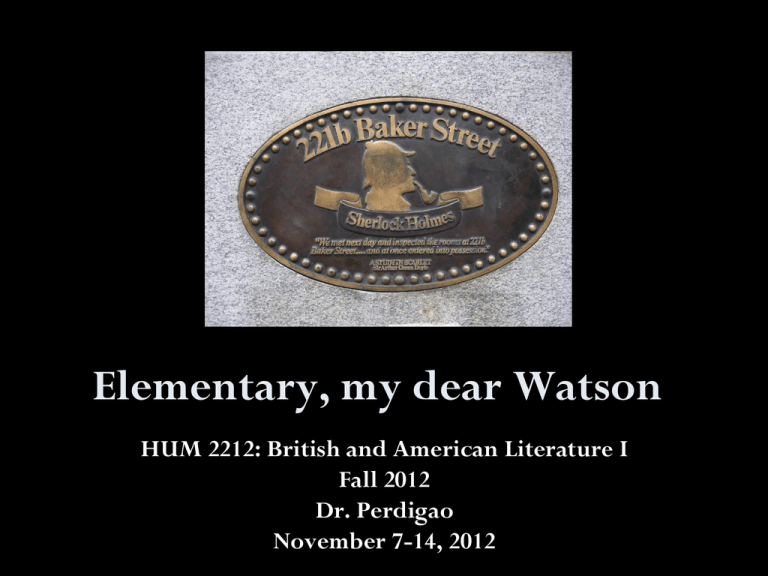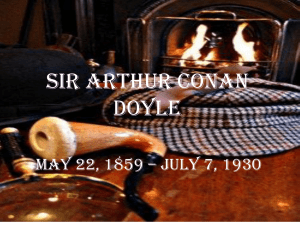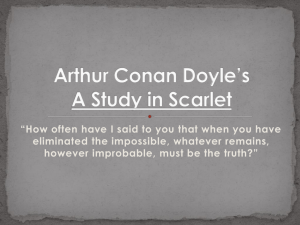Doyled Again
advertisement

Elementary, my dear Watson HUM 2212: British and American Literature I Fall 2012 Dr. Perdigao November 7-14, 2012 Doyled Again • Sir Arthur Conan Doyle born in Edinburgh, Scotland in 1859 • Studied medicine at Edinburgh University and settled in London • Wrote while in practice in London • A Study in Scarlet as first successful story, appeared in Beeton’s Christmas Annual in 1887 • Left medicine after success of The Sign of Four in 1890 to write full-time • Killed off Sherlock Holmes character in “The Final Problem,” published in 1893, but, due to public outcry and protest, resurrected the character • Doyle as historian, whaler, athlete, war correspondent, and spiritualist • Knighted in 1902 for work in South African field hospital during the Boer War • Died in 1930 Doyled Again • When A Study in Scarlet came out, Doyle received a flat fee of 25 pounds (about $120) • Magazine did not sell out, mixed reviews (some noting indebtedness to Edgar Allan Poe’s C. Auguste Dupin) • Book publication led to Lippincott’s Monthly Magazine buying The Sign of Four in 1890 • The Strand magazine (the Life magazine of its era) published “A Scandal in Bohemia” in 1891 and new stories featuring Holmes sold out • Magazine changed owners in 1951 and new issue featured Holmes on cover, showing longstanding connection between the magazine and the character • The Hound of the Baskervilles offered return of Holmes that ran from August 1901 until April of the following year, then “The Empty House” • Doyle continued writing stories until 1927, with Holmes retiring in 1903 or 1904 to tend bees, with “His Last Bow” taking him out of retirement Framing Holmes • 4 novels and 56 short stories featuring the character • Holmes believed to have a birthdate of January 6, 1854 • Lives at 221b Baker Street, since 1881 • Studies at university—believed to be chemistry; chemistry lab in house • Brother Mycroft, government official • Lives with Dr. John H. Watson until his marriage, then again after his wife’s death • Landlady Mrs. Hudson • Stories as frame narratives (story within the story) Disguises • Watson appears in 56 of the 60 published adventures • 2 told by third-person narrator (“The Adventure of the Mazarin Stone” and “His Last Bow”) and Holmes narrates “The Adventure of the Lion’s Mane” and “The Adventure of the Blanched Soldier”; “The Musgrave Ritual” and “Gloria Scott” are told from Holmes’ memories while Watson narrates • Partnership between 1881-1914 • Masculinist character of the period in late nineteenth-century English society • Guinness World Records lists Holmes as most portrayed movie character—75 actors in 211 films • 1905 silent screen debut (although 1900 vignette Sherlock Holmes Baffled) • Fourteen Universal features starring Basil Rathbone from 1939-1946, with Nigel Bruce as comical Watson character (overweight, bumbler) The Adventures of Sherlock Holmes (1939) Basil Rathbone and Nigel Bruce (Holmes and Watson) Deerstalker cap and pipe Buster Keaton Doyled Again • Buster Keaton in Sherlock Jr. (1924) • The Return of Sherlock Holmes (1929), starring Clive Brook, first sound film to feature the character and one given credit for the line “Elementary, my dear Watson” • Without a Clue (1988) • On television, Jeremy Brett played role from 1984-1994 • House and CSI play with references to Holmes (“Who Shot Sherlock?”) • BBC series Sherlock (2010-present) (by writers of Doctor Who)—blogging • Elementary (2012-present) Cyberworld Sherlock? Cyberworld Sherlock? Doyled Again • Guy Ritchie: “What you’ve got going on with our movie is a complete reinvention process of an iconic figure . . . We have gone back to the books themselves. In them, Holmes is a very compelling hero: an inquisitive, tortured, complex genius, who is also an action man.” (http://www.telegraph.co.uk/culture/film/6789921/Sherlock-Holmes-pipedreams.html) • As “James Bond in 1891” Elementary… • Watson’s role as storyteller and buffer between Holmes and reader • “appear[s] less astute than the reader, rendering himself more approachable than the aloof and awesome Holmes, without sacrificing respect for his native intelligence” (Estleman xiii). • Characteristic Watson: bravery in The Hound of the Baskervilles and “The Adventure of Charles Augustus Milverton”; past 60 years old, offered surgical skills to England on eve of WWI (Estleman x). • Gambling problem—Holmes with Watson’s checkbook locked away; theories about multiple marriages • Holmes’ use of cocaine, morphine • Watson’s rehabilitation of Holmes Reframing • Holmes’ characterization—counter to Lestrade (who jumps to conclusions, like us) • Flair for showmanship, arrogance • Starts out poor, “A Scandal in Bohemia” brings him 1000 pounds (at time, 60100 pounds as decent salary) • Does pro bono work, charges wealthy clients more Another Fight Club? • Baritsu vs. Wing-Chun Kung Fu • Bartitsu, martial art created by British engineer Edward-William Barton Wright (1860-1951) • Misspelling in The Times article in 1901; two years later, “The Adventure of the Empty House” introduced the style • Bartitsu is mix of Japanese jujitsu and English and French boxing • Conan Doyle as amateur boxer • Robert Downey Jr. and Guy Ritchie study Wing-Chun Kung Fu (Bruce Lee popularized), change for film Reasoning and unreasoning • Forensic science • Pseudo-scientific approach—phrenology • Abductive reasoning • Criminology • Fingerprints, gun powder residue • Science vs. magic, supernatural • Holmes as ultimate rationalist but Doyle as spiritualist, connection to Harry Houdini, the Cottingley fairy case • Doyle reading Grimm’s fairy tales at time of writing “The Adventure of the Sussex Vampire” • Ritchie’s Sherlock Holmes, debunking magic, triumph of science The Woman • Irene Adler is only woman to impress him; she only appears in “A Scandal in Bohemia” but is mentioned throughout the stories as his equal • “In his eyes she eclipses and predominates the whole of her sex” (239). • Idea that Holmes is asexual, doesn’t understand Watson’s interest in Mary • Degrading to women • Disguises—gender-bending performances in story • March 1888 as setting • References to Study in Scarlet (240) • Watson comments that Holmes’ deductions would lead to accusations of witchcraft (241) • Idea of unobserved life Secrets and Lies • Paper made in Bohemia • German—syntax • Count Van Kramm, Bohemian nobleman (244) • King—Wilhlem Gottsreich Sigismond von Ormstein, Grand Duke of CasselFelstein and hereditary King of Bohemia (245) • Connection to Irene Adler • Looks up in the index—American, NJ born in 1858, performed as prima donna Imperial Opera of Warsaw • Marriage to Godfrey Norton • Women as “naturally secretive” (255) Gender Equity? • “Fire” • Proposed costume in “A Scandal in Belgravia” • Leaves for the Continent • Photograph of Irene Adler left • Letter • “Male costume is nothing new to me. I often take advantage of the freedom which it gives” (261) Rebooting? • Resurrection of Holmes with “The Empty House” in 1903 • Lapse in Holmes narrative from 1891 to 1894 between “The Final Problem” and “The Empty House” • Passing of Victorian age with turn to the twentieth century, now to the twentyfirst century Traces • “The Speckled Band” (published in 1892, set in 1883) • “The Speckled Blonde” • Description of “methods”: http://www.thescienceofdeduction.co.uk/ • http://www.johnwatsonblog.co.uk/ • Supernatural and fantastic • Roylotts of Stoke Moran, Surrey • Stepdaughter of last survivor • Usher? (Not that Usher) • Stepfather—medical career in Calcutta • Exotic—India Threads • Twin Julia • Usher Usher? • Railway accident • Chopin story? • Mania, residing in tropics—madness (1834) • Violence, fear of exposure • Hyde? • Sister died two years ago (1834) • Aunt Miss Honoria Westphail • Sister visited, engaged to major of Marines • Died of shock Blogging 101 • “Locked room” mystery • “It was the band!” (1836) • Or gipsies? • Different interpretations • “dark enough, and sinister enough” (1838), not most • Grimesby Roylott appears (1839) • Holmes’ strength—straightens poker • Threat of danger (1844) • Come anyway • Difficulty in reasoning, insufficient data (1848) Blogging 101 • Eastern training—exotic, dangerous (to other scientists, British/India divide)






